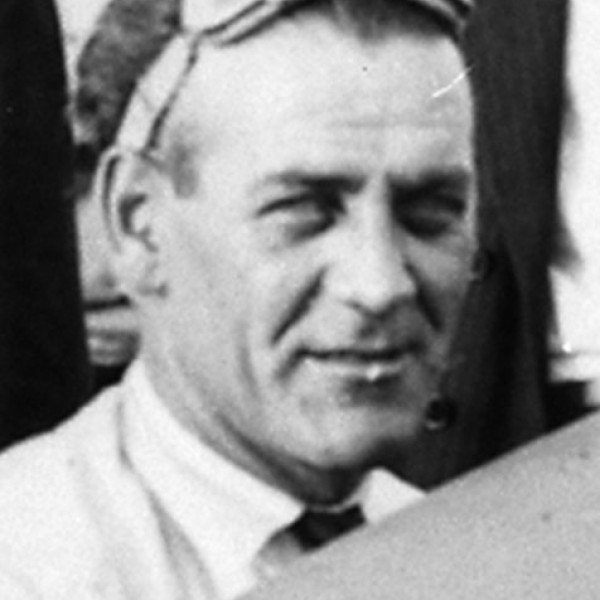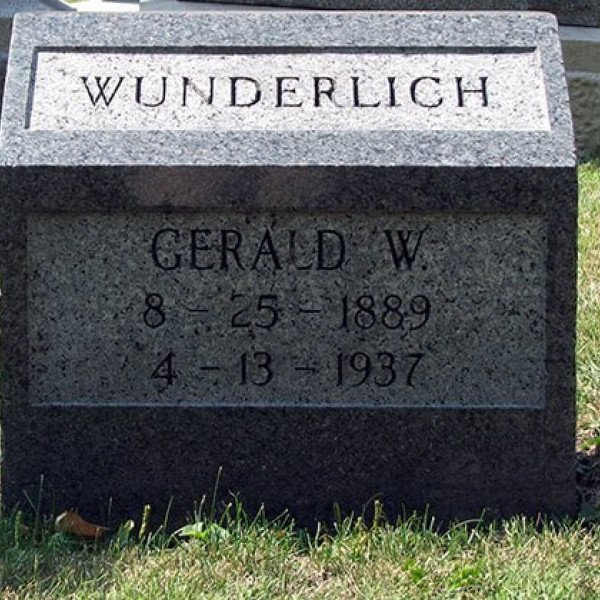Gerald “Jerry” Wunderlich (sometimes spelled Wonderlich) was born on August 25, 1889 in Chicago, Illinois. His biological parents are unknown. When he was about three years old he was adopted by Reinhold and Emma (Schultz) Wunderlich of Bloomington, IL.
Reinhold Wunderlich was born in Germany around 1838. After graduating in 1858 from the University of Tübingen with a medical degree, he practiced medicine in Germany and IqueQue, Chili until 1868 when he moved to Bloomington. From 1868 through 1880 he had a private medical practice in Bloomington and then joined the medical staff of St. Joseph’s Hospital, located on the southeast corner of Morris Avenue and Taylor Street. He remained on the hospital staff until his death.
In October of 1877 Reinhold married Emma Schultz and they lived at 234 E. Front Street. Emma was born on March 15, 1853 in Cleveland, Ohio. Emma and Reinhold had one biological son, Carl August Reitaw “Otto” Wunderlich, who died in infancy. Several years after the tragedy, the Wunderlich’s adopted Jerry. Shortly after the adoption, Reinhold passed away on February 5, 1893 due to an enlarged liver. Emma Wunderlich was left to raise Jerry on her own.
Jerry attended school in Bloomington before graduating from St. John’s Northwestern Military Academy in Delafield, Wisconsin, “a private, all-male college preparatory and leadership development school.” After his return to Bloomington, it was said that he was married to a woman named Iva as early as 1915. Not much is known about their marriage other than they lived at his mother’s home at 708 E. Front Street in Bloomington. Eventually he became a car salesman for Kissel Car Sales Agency, located at 210 E. Front Street in Bloomington. He was later a sales agent for Velie, Frayer-Miller, and Chrysler among other car makers.
Jerry’s career in auto sales likely peaked his interest toward auto racing. Jerry started small by attending county fairs like the one held in LeRoy, IL where amateur racing was performed. Soon after he began racing at a professional level. In 1922 he competed in the Indianapolis 500. The Indianapolis Motor Speedway opened in 1909 and the track was made of tar and crushed stone. When the track opened, it hosted several small events including motorcycle races. That same year, because of two fatal accidents and the break-up of the primitive asphalt, that track was replaced with paving bricks. This made the track steadier. A two foot tall wall was also built that encompassed the track. On May 30th, 1911 the first Indianapolis 500 race was held with 40 starters. The winner was Ray Harroun who drove a Marmon Model 32-based Wasp racer. When Jerry competed in 1922 he drove a Duesenberg Straight-Eight automobile with an eight cylinder engine, single- and double-overhead camshafts, three- and four-valve heads, superchargers and aluminum castings. Jerry finished in 6th place in a race that took him 5 hours and 38 minutes to complete at an average speed of 88.8mph. Today, a driver expects to finish in nearly half that time at an average rate of 215-223mph. He won $2,200 for his 6th place finish (which would be $28,000 in 2012). This was an impressive feat considering his opponents were big names in auto racing like Ralph DePalma and Eddie Hearne.
Racing at this time was a very dangerous sport. On September 17, 1922 Jerry participated in a race at the Kansas City Speedway that was the scene of a deadly accident. A veteran automobile racer, Roscoe Sarles, was burned to death after his car crashed into another car. Sarles’ car jumped the rail of the speedway, dropped 25 feet, and was pinned beneath the wreckage. Four other drivers were injured in the same race along with several mechanics, who at that time rode in the car with the driver. Jerry finished the race in fifth place and escaped without injury. Jerry would not be so lucky just two years later. On June 14, 1924 in Altoona, PA, Jerry was driving his “Miller” racecar (built by legendary racecar builder Harry Miller), when he wrecked on the 160th lap. “In the 250-mile race, his car left the track and skidded into the field.” His injuries were so severe that several newspapers mistakenly reported that he died as a result of his injuries. Despite the papers faulty reporting, Jerry survived and continued to race another day.
Wunderlich continued to race on the professional circuit traveling around the country and competing in different events. He nearly surpassed the national speed record at Washington’s Birthday race on February 24, 1924 at the Beverly Hills Speedway in Los Angeles, California. But Harlan Fengler, known as the “boy wonder of board and brick speedways,” beat him by one-tenth of a mile-per-hour and established the world record for competition and distance by averaging 116mph. Wunderlich’s speed was recorded at 115.9mph. By the close of the 1924 racing season, Jerry stood tenth in the point standings having competed in six of nine races. He earned around $7,000 (or about $88,500 in 2012). That same year he finished 12th in the Indianapolis 500.
Other races took Jerry to the West coast and soon onto the silver screen. At this time the “Roaring Twenties” saw a rise in silent films with actors who became major icons of the day. The racing and film industry joined forces to make a new genre of movies. Jerry served as a driver on several racing films but it is not known how many because he rarely received billing. “These movies were looking to Jerry for fast action in some of the thrillers of that day. He took part in many scenes which made the films attractive to thousands of spectators. Of course he got well paid for this sort of dangerous work,” The Daily Pantagraph wrote. Jerry also supposedly met and married his second wife Agnes Ayres during this time. Agnes Ayres was a Hollywood star who had appeared in many films like “The Sheik” opposite Rudolph Valentino in 1921. Ayres and Wunderlich worked on the movie “Racing Hearts” in 1923. It is unknown when or if they were married or how long, in fact, the marriage lasted. Married or not, they “divorced” and Jerry later returned to Bloomington.
Jerry retired from racing in 1932 and returned to Bloomington. He lived with his mother at her home on Front Street until she passed away in 1934. He then took up residence at the Hotel Tilden-Hall located at 219 W. Washington Street. Just five short years after he retired, Wunderlich suffered a stroke and was taken to Brokaw Hospital where died at the age of 48 on April 9, 1937. He was buried in Evergreen Memorial Cemetery in Bloomington, IL next to his adoptive parents Reinhold and Emma.
Wunderlich, Gerald “Jerry” White
(August 25, 1889 — April 9, 1937)
Written by Emily Swartz. 7 min read.




MLA:
Swartz, Emily. “Wunderlich, Gerald “Jerry” White.” McLean County Museum of History, 2012, mchistory.org/research/biographies/wunderlich-gerald-jerry-white. Accessed 06 Jan. 2026. APA:
Swartz, E. (2012). Wunderlich, Gerald “Jerry” White. McLean County Museum of History, https://mchistory.org/research/biographies/wunderlich-gerald-jerry-white Chicago:
Swartz, Emily. “Wunderlich, Gerald “Jerry” White.” McLean County Museum of History. 2012. Retrieved from https://mchistory.org/research/biographies/wunderlich-gerald-jerry-white
Swartz, Emily. “Wunderlich, Gerald “Jerry” White.” McLean County Museum of History, 2012, mchistory.org/research/biographies/wunderlich-gerald-jerry-white. Accessed 06 Jan. 2026. APA:
Swartz, E. (2012). Wunderlich, Gerald “Jerry” White. McLean County Museum of History, https://mchistory.org/research/biographies/wunderlich-gerald-jerry-white Chicago:
Swartz, Emily. “Wunderlich, Gerald “Jerry” White.” McLean County Museum of History. 2012. Retrieved from https://mchistory.org/research/biographies/wunderlich-gerald-jerry-white